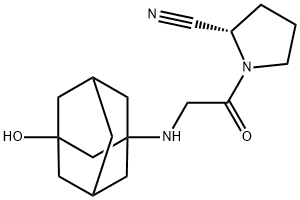Uses
Glyptins are class of oral anti-hyperglycemic agents that inhibit dipeptidyl peptidase 4 (DPP-4), which can act as a serine exopeptidase. Aside from their use in type 2 diabetes, gliptins have positive cardiovascular and anti-inflammtatory effects. Antidiabetic.
Indications and Usage
Vildagliptin (vildagliptin), developed by Novartis (Novartis) Pharmaceutical Co., Ltd, is another oral administrated inhibitor of Dipeptidyl peptidase-IV after sitagliptin (sitagliptin). In 2008, it is approved for marketing in the European Union for the treatment of type 2 diabetes.
Diabetes is a chronic metabolic disease with its prevalence being increased year by year. Type 2 diabetes is a complicated diseases caused with the combined action between polygenic genetic factors and environmental factors.
Dipeptidyl peptidase IV (DPP-IV) inhibitors are a new class of anti-diabetic drugs which induces and facilitate the biosynthesis and secretion of insulin. It plays a role in lowering the blood carbohydrate concentration through multiple mechanisms such as inhibiting the β cell apoptosis, inhibiting glucagon secretion and reducing food intake. During its lowering effect on reducing blood carbohydrate levels, it can also reverse the situation of deteriorating function of pancreas islet for diabetic patients at the same time. Vildagliptin is the representative of drugs among the dipeptidyl peptidase inhibitor. It exhibited a good anti-diabetic effects and tolerance no matter whether it is being administered alone or in combination with metformin and insulin medication in clinical studies.
Mechanisms of Action
Vildagliptin is a selective, competitive and reversible DPP-4 inhibitor. Glucose-dependent insulinotropic polypeptide (GIP) and glucagon-like peptide 21 (GLP21) are important hormones that regulate body glucose concentration and have the same functions as intestinal insulin. Type-2 diabetes patients suffer from GIP insulin secretion failure, so only their GLP21 can promote insulin secretion by affecting receptors on islet beta cell membranes. GLP21 can also inhibit glucagon secretion and inhibit gastric clearing to extend the feeling of fullness (control appetite). DPP-4 binds with proteins in many types of tissues, including tissue in the kidney, liver, small intestine brush border, pancreatic duct, lymph cells, and endothelial cells, and it can deactivate GLP21 by hydrolyzing its N-terminal position-2 alanine. Vildagliptin binds with DPP-4 to produce a DPP-4 compound and inhibit its activity. It increases GLP21 concentration and promotes islet beta cells to produce insulin, while also lowering glucagon concentration, thus lowering blood sugar. Vildagliptin has not noticeable effects on weight.
Adverse reactions
Most common adverse reactions include headache, nasopharyngitis, coughing, constipation, dizziness and excess sweating. There have been very rare cases of hypotension, but it is unclear if conditions are related to this drug. Almost all research shows that the hypoglycemia occurrence rate while using Vildagliptin is similar to the rate when using a placebo. Control trials showed that compared to thiazolidinediones, Vildagliptin causes a similar occurrence rate of headaches, rashes, and other adverse reactions, but Vildagliptin has a lower occurrence rate of adverse reactions forcing patients to cease treatment and of severe adverse reactions.
Description
Vildagliptin, a DPP-4 inhibitor, was launched for the oral treatment of type 2 diabetes. Vildagliptin is the second DPP-4 inhibitor to reach the market behind sitagliptin, which was introduced in 2006. DPP-4 inhibitors act by slowing the inactivation of incretins, which are endogenous peptides involved in the physiologic regulation of glucose homeostasis. When blood glucose concentrations are normal or elevated, GLP-1 and GIP increase the synthesis and release of insulin from pancreatic βcells via intracellular signaling pathways involving cAMP. GLP-1 also lowers glucagon secretion from pancreatic α cells, which leads to reduced hepatic glucose production. However, although GLP-1 and GIP effectively lower blood glucose, they are short-lived as a result of rapid inactivation by the ubiquitous serine protease DPP-4. By inhibiting DPP-4, vildagliptin increases the concentration and duration of active incretin levels, which in turn results in increased insulin release and decreased glucagon levels in a glucose-dependent manner. Both vildagliptin and sitagliptin are potent, competitive, reversible inhibitors of DPP- 4 (IC
50=3.5 and 18 nM, respectively), and they both show slow, tight-binding inhibition kinetics.
Chemical Properties
White Solid
Uses
The major metabolite of Vildagliptin
Uses
A metabolite of Vildagliptin
Uses
Vildagliptin (LAF-237) inhibits DPP?4 with IC50 of 2.3 nM
Uses
Labelled Vildagliptin. It is a new oral anti-hyperglycemic agent of a new dipeptidyl peptidase-IV (DPP-IV) inhibitor class of drugs. Antidiabetic.
Definition
ChEBI: Vildagliptin is an amino acid amide.
Clinical Use
Dipeptidyl peptidase 4 inhibitor:
Treatment of type 2 diabetes mellitus in combination with other antidiabetic drugs
Side effects
The most common adverse events reported in patients receiving vildagliptin included headache, nasopharyngitis, cough, constipation, dizziness, and increased sweating. Vildagliptin is not recommended for patients with liver impairment.
Synthesis
Vildagliptin is chemically derived in three steps starting from L-prolinamide via acylation with chloroacetyl chloride to produce 1-(chloroacetyl)-L-prolinamide, subsequent dehydration of the carboxamide group to the nitrile with trifluoroacetic anhydride, and condensation of the 1-(chloroacetyl)-L-prolinenitrile intermediate with 3-hydroxyadamantan-1-amine.
Metabolism
About 69
% of a dose of vildagliptin is metabolised,
mainly by hydrolysis in the kidney to inactive metabolites.
About 85
% of a dose is excreted in the urine (23
% as
unchanged drug), and 15
% in the faeces.
References
1) Balas?et al.?(2007),?The dipeptidyl peptidase IV inhibitor vildagliptin suppresses endogenous glucose production and enhances islet function after single-dose administration in type 2 diabetic patients;? J. Clin. Endocrinol. Metab.,?92?1249
2) Ahren?et al. (2004),?Inhibition of dipeptidyl peptidase-4 reduces glycemia, sustains insulin levels and reduces glucagon levels in type 2 diabetes;? J. Clin. Endocrinol. Metab., 89?2078
3) Kosaraju?et al. (2013),?Vildagliptin: an anti-diabetes agent ameliorates cognitive deficits and pathology observed in streptozotocin-induced Alzheimer’s disease;? J. Pharm. Pharmacol.,?65?1773
4) Shimizu?et al. (2012),?DPP4 inhibitor vildagliptin preserves? β-cell mass through amelioration of endoplasmic reticulum stress in C/EBPB transgenic mice;? J. Mol. Endocrinol.,?49?125




